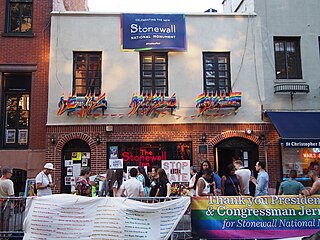Related Research Articles

Transphobia consists of negative attitudes, feelings, or actions towards transgender people or transness in general. Transphobia can include fear, aversion, hatred, violence or anger towards people who do not conform to social gender roles. Transphobia is a type of prejudice and discrimination, similar to racism, sexism, or ableism, and it is closely associated with homophobia. People of color who are transgender experience discrimination above and beyond that which can be explained as a simple combination of transphobia and racism.

The LGBT community is a loosely defined grouping of lesbian, gay, bisexual, and transgender individuals united by a common culture and social movements. These communities generally celebrate pride, diversity, individuality, and sexuality. LGBT activists and sociologists see LGBT community-building as a counterweight to heterosexism, homophobia, biphobia, transphobia, sexualism, and conformist pressures that exist in the larger society. The term pride or sometimes gay pride expresses the LGBT community's identity and collective strength; pride parades provide both a prime example of the use and a demonstration of the general meaning of the term. The LGBT community is diverse in political affiliation. Not all people who are lesbian, gay, bisexual, or transgender consider themselves part of the LGBT community.

Biphobia is aversion toward bisexuality or people who are identified or perceived as being bisexual. Similarly to homophobia, it refers to hatred and prejudice specifically against those identified or perceived as being in the bisexual community. It can take the form of denial that bisexuality is a genuine sexual orientation, or of negative stereotypes about people who are bisexual. Other forms of biphobia include bisexual erasure.

The field of psychology has extensively studied homosexuality as a human sexual orientation. The American Psychiatric Association listed homosexuality in the DSM-I in 1952 as a "sociopathic personality disturbance," but that classification came under scrutiny in research funded by the National Institute of Mental Health. That research and subsequent studies consistently failed to produce any empirical or scientific basis for regarding homosexuality as anything other than a natural and normal sexual orientation that is a healthy and positive expression of human sexuality. As a result of this scientific research, the American Psychiatric Association removed homosexuality from the DSM-II in 1973. Upon a thorough review of the scientific data, the American Psychological Association followed in 1975 and also called on all mental health professionals to take the lead in "removing the stigma of mental illness that has long been associated" with homosexuality. In 1993, the National Association of Social Workers adopted the same position as the American Psychiatric Association and the American Psychological Association, in recognition of scientific evidence. The World Health Organization, which listed homosexuality in the ICD-9 in 1977, removed homosexuality from the ICD-10 which was endorsed by the 43rd World Health Assembly on 17 May 1990.

LGBT culture is a culture shared by lesbian, gay, bisexual, transgender, and queer individuals. It is sometimes referred to as queer culture, while the term gay culture may be used to mean either "LGBT culture" or homosexual culture specifically.
A sexual minority is a demographic whose sexual identity, orientation or practices differ from the majority of the surrounding society. Primarily used to refer to lesbian, gay, bisexual, or non-heterosexual individuals, it can also refer to transgender, non-binary or intersex individuals.

Suicidal ideation, or suicidal thoughts, is the thought process of having ideas, or ruminations about the possibility of completing suicide. It is not a diagnosis but is a symptom of some mental disorders, use of certain psychoactive drugs, and can also occur in response to adverse life events without the presence of a mental disorder.

Homosexuality is sexual attraction, romantic attraction, or sexual behavior between members of the same sex or gender. As a sexual orientation, homosexuality is "an enduring pattern of emotional, romantic, and/or sexual attractions" exclusively to people of the same sex or gender. It "also refers to a person's sense of identity based on those attractions, related behaviors, and membership in a community of others who share those attractions."

The questioning of one's sexual orientation, sexual identity, gender, or all three is a process of exploration by people who may be unsure, still exploring, or concerned about applying a social label to themselves for various reasons. The letter "Q" is sometimes added to the end of the acronym LGBT ; the "Q" can refer to either queer or questioning.
Various issues in medicine relate to lesbian, gay, bisexual, and transgender people. According to the US Gay and Lesbian Medical Association (GLMA), besides HIV/AIDS, issues related to LGBT health include breast and cervical cancer, hepatitis, mental health, substance use disorders, alcohol use, tobacco use, depression, access to care for transgender persons, issues surrounding marriage and family recognition, conversion therapy, refusal clause legislation, and laws that are intended to "immunize health care professionals from liability for discriminating against persons of whom they disapprove."
Research has found that attempted suicide rates and suicidal ideation among lesbian, gay, bisexual, and transgender (LGBT) youth are significantly higher than among the general population.

LGBT sex education is a sex education program within a school, university, or community center that addresses the sexual health needs of LGBT people.

Transgender youth are children or adolescents who do not identify with the sex they were assigned at birth. Because transgender youth are usually dependent on their parents for care, shelter, financial support, and other needs, they face different challenges compared to adults. According to the World Professional Association for Transgender Health, the American Psychological Association, and the American Academy of Pediatrics, appropriate care for transgender youth may include supportive mental health care, social transition, and/or puberty blockers, which delay puberty and the development of secondary sex characteristics to allow children more time to explore their gender identity.
Bullying suicide are considered together when the cause of suicide is attributable to the victim having been bullied, either in person or via social media. Writers Neil Marr and Tim Field wrote about it in their 2001 book Bullycide: Death at Playtime.
The modern South Korean LGBT rights movement arose in the 1990s, with several small organizations seeking to combat sexual orientation and gender identity discrimination.
In society at large, LGBT individuals, especially youth, are at a higher risk of depression, anxiety, and suicide. Though causes of mental health risk are complex, one often cited reason for these higher risks is minority stress stemming from societal anti-LGBT biases and stigma, rejection, and internalized homophobia.
LGBT psychology is a field of psychology of surrounding the lives of LGBTQ+ individuals, in the particular the diverse range of psychological perspectives and experiences of these individuals. It covers different aspects such as identity development including the coming out process, parenting and family practices and support for LGBTQ+ individuals, as well as issues of prejudice and discrimination involving the LGBT community.
Due to the increased vulnerability that lesbian, gay, bisexual, and transgender (LGBT) youth face compared to their non-LGBT peers, there are notable differences in the mental and physical health risks tied to the social interactions of LGBT youth compared to the social interactions of heterosexual youth. Youth of the LGBT community experience greater encounters with not only health risks, but also violence and bullying, due to their sexual orientation, self-identification, and lack of support from institutions in society.

The health access and health vulnerabilities experienced by the lesbian, gay, bisexual, transgender, queer or questioning, intersex, asexual (LGBTQIA) community in South Korea are influenced by the state's continuous failure to pass anti-discrimination laws that prohibit discrimination based on sexual orientation and gender identity. The construction and reinforcement of the South Korean national subject, "kungmin," and the basis of Confucianism and Christian churches perpetuates heteronormativity, homophobia, discrimination, and harassment towards the LGBTQI community. The minority stress model can be used to explain the consequences of daily social stressors, like prejudice and discrimination, that sexual minorities face that result in a hostile social environment. Exposure to a hostile environment can lead to health disparities within the LGBTQI community, like higher rates of depression, suicide, suicide ideation, and health risk behavior. Korean public opinion and acceptance of the LGBTQI community have improved over the past two decades, but change has been slow, considering the increased opposition from Christian activist groups. In South Korea, obstacles to LGBTQI healthcare are characterized by discrimination, a lack of medical professionals and medical facilities trained to care for LGBTQI individuals, a lack of legal protection and regulation from governmental entities, and the lack of medical care coverage to provide for the health care needs of LGBTQI individuals. The presence of Korean LGBTQI organizations is a response to the lack of access to healthcare and human rights protection in South Korea. It is also important to note that research that focuses on Korean LGBTQI health access and vulnerabilities is limited in quantity and quality as pushback from the public and government continues.
People who are LGBT are significantly more likely than those who are not to experience depression, PTSD, and generalized anxiety disorder.
References
- ↑ Zimmerman, Gregory M.; Rees, Carter; Posick, Chad; Zimmerman, Lori A. (May 2016). "The power of (Mis)perception: Rethinking suicide contagion in youth friendship networks". Social Science & Medicine. 157: 31–38. doi:10.1016/j.socscimed.2016.03.046. PMID 27060539.
- 1 2 3 4 Kim, Geum Hee; Ahn, Hyeong Sik; Kim, Hyun Jung (December 2016). "Type of sexual intercourse experience and suicidal ideation, plans, and attempts among youths: a cross-sectional study in South Korea". BMC Public Health. 16 (1): 1229. doi: 10.1186/s12889-016-3895-y . ISSN 1471-2458. PMC 5142152 . PMID 27923371.
- 1 2 Hatchel, Tyler; Merrin, Gabriel J.; Espelage, and Dorothy (2019-04-03). "Peer victimization and suicidality among LGBTQ youth: the roles of school belonging, self-compassion, and parental support". Journal of LGBT Youth. 16 (2): 134–156. doi:10.1080/19361653.2018.1543036. ISSN 1936-1653. S2CID 149893349.
- ↑ McDermott, Elizabeth; Hughes, Elizabeth; Rawlings, Victoria (February 2018). "Norms and normalisation: understanding lesbian, gay, bisexual, transgender and queer youth, suicidality and help-seeking". Culture, Health & Sexuality. 20 (2): 156–172. doi: 10.1080/13691058.2017.1335435 . ISSN 1369-1058. PMID 28641479.
- ↑ Iacono, Gio (June 2019). "An Affirmative Mindfulness Approach for Lesbian, Gay, Bisexual, Transgender, and Queer Youth Mental Health". Clinical Social Work Journal. 47 (2): 156–166. doi:10.1007/s10615-018-0656-7. ISSN 0091-1674. S2CID 150363524.
- ↑ Sohn, Min; Oh, Heymin; Lee, Sang-Kyu; Potenza, Marc N. (2017-10-09). "Suicidal Ideation and Related Factors Among Korean High School Students". The Journal of School Nursing. 34 (4): 310–318. doi:10.1177/1059840517734290. ISSN 1059-8405. PMID 28992754. S2CID 1207678.
- 1 2 3 Kim, SungYeon; Yang, Eunjoo (February 2015). "Suicidal Ideation in Gay Men and Lesbians in South Korea: A Test of the Interpersonal-Psychological Model". Suicide and Life-Threatening Behavior. 45 (1): 98–110. doi:10.1111/sltb.12119. PMID 25220014.
- ↑ Herek, Gregory M. (1998). Stigma and sexual orientation : understanding prejudice against lesbians, gay men, and bisexuals. Thousand Oaks: Sage Publications. ISBN 978-0803953857.
- ↑ ANDERSON, C., & LEE, M. (2011). Tolerance of homosexuality among Korean university students. Autumn Academic Conference Papers of Korean Administrative Association,1–23.
- ↑ Rainbow Action. (2017). Human Rights Violations on the Basis of Sexual Orientation, Gender Identity, and HIV Status in the Republic of Korea.Retrieved from https://ilga.org/downloads/stakeholders_report_Republic_of_Korea_UPR28.pdf
- 1 2 "Protecting sexual minorities". The Korea Times . 2013-08-23. Retrieved 2019-06-14.